- Most Californians see preschool as important to K–12 success.
The overwhelming majority of Californians say attending preschool is very important (68%) or somewhat important (21%) to student success in elementary and secondary education. Since 2006, at least six in 10 Californians have said attending preschool is very important. Indeed, a majority of residents across all regions and demographic groups consider preschool to be very important to future academic success. Across parties, Democrats (73%) and independents (65%) are much more likely than Republicans (48%) to hold this view. There is also variation among racial/ethnic groups, with Latinos (87%) and blacks (77%) more likely than whites (59%) and Asians (53%) to say preschool is very important. Finally, parents with children age 18 or younger are more likely than those without to see preschool as very important to a student’s educational success (78% to 63%).
How important is attending preschool to a student’s success in kindergarten through grade 12?
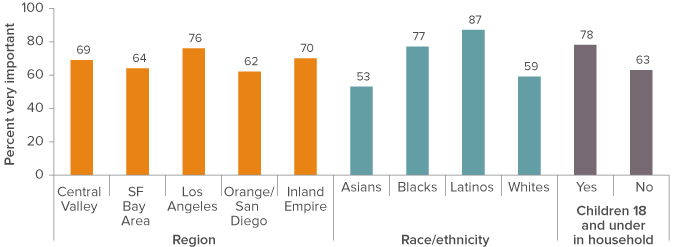
SOURCE: PPIC Statewide Survey, April 2016. Margin of error for all adults is ±3.5. The margins of error for subgroups are larger.
- Concerns about kindergarten readiness vary across demographic groups.
Half of Californians are very concerned that children in low-income areas are less likely than other children to be ready for kindergarten, and an additional 31% are somewhat concerned. There are stark differences across racial/ethnic groups—66% of blacks and 56% of Latinos say they are very concerned, compared to 46% of whites and 41% of Asians. Women are also more likely than men to be very concerned about kindergarten readiness in low-income areas (55% to 43%). Notably, recent research by PPIC shows that fewer children from low-income families attend preschool, and those who do are often in public programs.
How concerned are you that children in lower-income areas are less likely than other children to be ready for kindergarten?
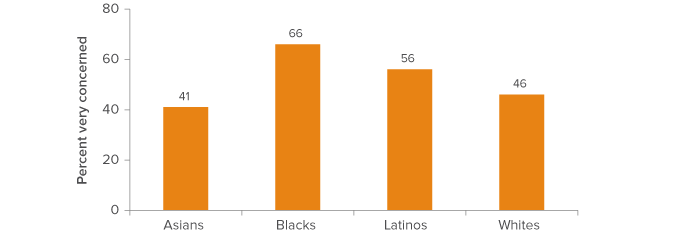
SOURCE: PPIC Statewide Survey, April 2016. Margin of error for all adults is ±3.5. The margins of error for subgroups are larger.
- Among potential challenges with preschool, affordability looms large.
Nearly three-quarters of Californians say affordability of preschool is a big problem (42%) or somewhat of a problem (32%). In contrast, preschool quality is less likely to be viewed as a big problem (20%, 36% somewhat of a problem). Across parties, Democrats (47%) and independents (46%) are more likely than Republicans (31%) to regard preschool affordability as a big problem facing California today. Overall, across all regions and demographic groups, one-third or more of Californians say affordability is a big problem, while one-third or fewer consider the quality of preschool education to be a big problem.
How much of a problem is the _____ of preschool education in California today?
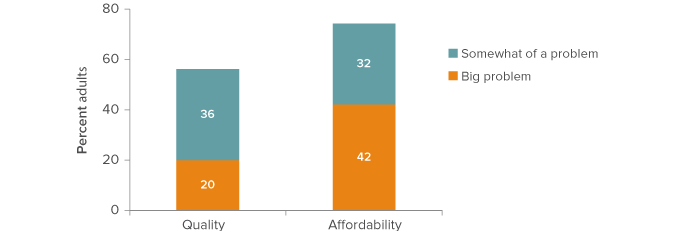
SOURCE: PPIC Statewide Survey, April 2016. Margin of error for all adults is ±3.5. The margins of error for subgroups are larger.
- A strong majority of Californians favor state funding for voluntary preschool.
Seventy-six percent of adults and 67 percent of likely voters say the state government should fund voluntary preschool programs for all four-years-olds in California. Findings were similar in April 2014 (73% adults, 63% likely voters). Support for state funding is widespread, with more than six in 10 Californians across all regions and demographic groups saying the government should fund voluntary preschool. However, there are notable partisan differences (87% Democrats, 68% independents, 44% Republicans), and support for state funding of voluntary preschool declines as age, education, and income increase.
Do you think that the state government should or should not fund voluntary preschool programs for all four-year-olds in California?
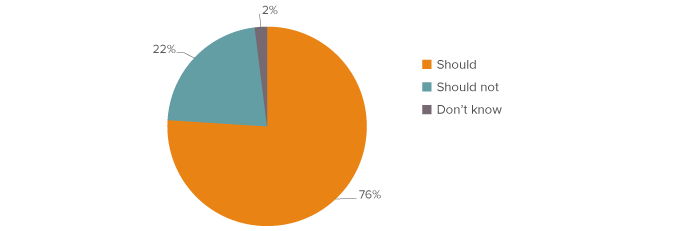
SOURCE: PPIC Statewide Survey, April 2016. Margin of error for all adults is ±3.5. The margins of error for subgroups are larger.
- There is solid support for using the budget surplus to fund public preschool.
Most Californians (63%) would prefer to use some of the surplus budget funds on public preschool and early childhood education, rather than pay down state debt and build up the reserve (34%). Similarly, in March 2015, Californians preferred restoring higher education funding (56%) over paying down debt (39%). However, in January 2016, when asked a more general question about whether they preferred restoring funding to social services or paying down the debt, Californians were divided (48% each). Again, partisan differences emerge as 71% of Democrats and 59% of independents prefer to use the surplus to fund preschool programs, while 71% of Republicans would rather pay down the debt. Across racial/ethnical groups, blacks (81%) and Latinos (78%) are far more likely than Asians (58%) and whites (52%) to prefer that the surplus go toward public preschool. Preference for increasing funding declines as age and education increase.
The state is projected to have a budget surplus of several billion dollars. In general, how would you prefer to use this extra money?
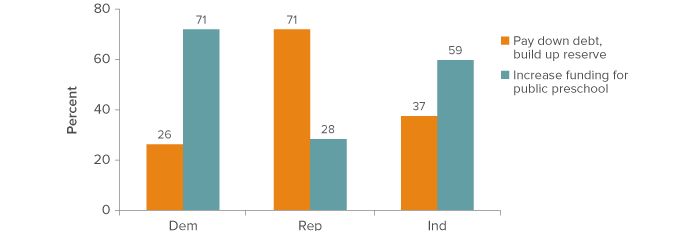
SOURCE: PPIC Statewide Survey, April 2016. Margin of error for all adults is ±3.5. The margins of error for subgroups are larger.
Supported with funding from the LA Partnership for Early Childhood Investment.
Related Content
Just the Facts: Public Preschools in California
Data Set: California Preschool-age Children by County
PPIC Statewide Survey: Californians and Education, April 2016
Topics
Health & Safety Net K–12 Education Population

